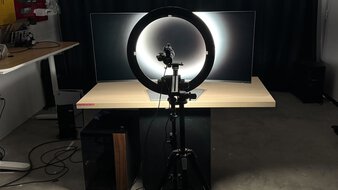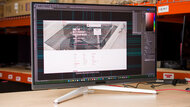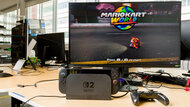
Ultrawide monitors are a class of displays with a 21:9 or 32:9 aspect ratio. Providing more horizontal screen space compared to traditional 16:9 monitors, these are great if you like opening multiple windows simultaneously. While many ultrawide monitors are designed with gaming in mind, most are good enough for productivity, making them versatile for work and play. If you aren't a gamer, you can even find ultrawide displays geared specifically for work use, as these tend to have higher resolutions and more features, like large USB hubs. There are models available at different price points, so you should think about your budget and how you're going to use it. We perform nearly 400 tests on every monitor to evaluate its performance with various usages to help you make that buying decision.
Most ultrawide displays have a 34-inch screen size, and there are others with 38, 40, and 45-inch screen sizes. There's even a class of displays known as super ultrawide, which have a 32:9 aspect ratio and generally have 49-inch screens. On top of that, ultrawides tend to have curved screens to bring the edges closer to you.
We've bought and tested more than 350 monitors, and below are our recommendations for the best widescreen monitors. See our picks for the best ultrawide gaming monitors, the best curved monitors, and the best 34-49-inch monitors.
Quick Look




Best Ultrawide Monitor
 Office7.2Editing8.8PC Gaming9.0Console Gaming8.9Brightness6.9Response Time9.9HDR Picture8.7SDR Picture9.9Color Accuracy9.0Size34"Pixel TypeOLEDMax Refresh Rate240 HzNative Resolution3440 x 1440See all our test resultsCurve Radius800R
Office7.2Editing8.8PC Gaming9.0Console Gaming8.9Brightness6.9Response Time9.9HDR Picture8.7SDR Picture9.9Color Accuracy9.0Size34"Pixel TypeOLEDMax Refresh Rate240 HzNative Resolution3440 x 1440See all our test resultsCurve Radius800RThe best ultrawide monitor we've tested is the LG 34GS95QE-B. It's a high-end OLED monitor that offers both fantastic performance and premium picture quality. It has a 34-inch display with an 800R curve that's meant to bring the edges of the screen closer to you, and its 3440x1440 resolution delivers okay image and text clarity. It also has gaming-focused features, with a 240Hz refresh rate and support for all common VRR formats to reduce screen tearing. Plus, it has a near-instantaneous response time at any refresh rate, so fast-moving objects look sharp.
It's fantastic for gaming in dark rooms as it displays deep and inky blacks without any blooming. It also makes some small highlights pop in HDR and displays a wide range of colors, but it doesn't get bright enough to fight a ton of glare, and bright colors aren't the most vivid. The biggest downside of using an OLED like this is the risk of burn-in with constant exposure to the same static elements over time, like if you only use it for work, but it's less of an issue if you vary your usage. Its pros outweigh the cons, though, and the best monitors in the ultrawide market are OLEDs.
Best Upper Mid-Range Ultrawide Monitor
 Office7.6Editing9.0PC Gaming8.9Console Gaming8.3Brightness6.7Response Time9.9HDR Picture9.3SDR Picture9.9Color Accuracy9.4Size34"Pixel TypeQD-OLEDMax Refresh Rate165 HzNative Resolution3440 x 1440See all our test resultsCurve Radius1800R
Office7.6Editing9.0PC Gaming8.9Console Gaming8.3Brightness6.7Response Time9.9HDR Picture9.3SDR Picture9.9Color Accuracy9.4Size34"Pixel TypeQD-OLEDMax Refresh Rate165 HzNative Resolution3440 x 1440See all our test resultsCurve Radius1800RIf you find that the LG 34GS95QE-B is too expensive, or you aren't going to take advantage of its high refresh rate, an upper mid-range option like the Dell Alienware AW3423DWF is a good alternative. It's different than the LG in a few ways, as it has a lower 165Hz refresh rate, so it doesn't feel as smooth or responsive. That said, it still has a fast response time for sharp motion at any refresh rate. While it's an OLED like the LG, and displays the same deep blacks in dark rooms, it actually has better picture quality with more vivid colors and brighter highlights.
Like the LG, this monitor has a curved screen that helps bring the edges closer to your field of vision. Lastly, another advantage of using this monitor is that it has incredibly accurate colors before any sort of calibration, which is useful for content creation. That said, it doesn't have many dedicated work features besides its USB hub, and you can look into the MSI MPG 341CQPX QD-OLED if you want more features, like a USB-C port and KVM switch. However, that monitor is harder to find.
Best Ultrawide Monitor For Work
 Office8.1Editing8.0PC Gaming6.3Console Gaming5.8Brightness7.7Response Time3.9HDR Picture6.2SDR Picture7.5Color Accuracy8.9Size40"Pixel TypeIPSMax Refresh Rate120 HzNative Resolution5120 x 2160See all our test resultsCurve Radius2500R
Office8.1Editing8.0PC Gaming6.3Console Gaming5.8Brightness7.7Response Time3.9HDR Picture6.2SDR Picture7.5Color Accuracy8.9Size40"Pixel TypeIPSMax Refresh Rate120 HzNative Resolution5120 x 2160See all our test resultsCurve Radius2500RIf you need something only for work and you don't need the gaming features of the OLED monitors mentioned above, then check out the Dell U4025QW. It's designed with work in mind, and it's different from other high-end options like the LG 34GS95QE-B or the Dell Alienware AW3423DWF because it doesn't deliver the same bright highlights and deep blacks. Instead of the worse picture quality, this monitor has a large 40-inch screen with a high 5120x2160 resolution, which is the equivalent of an ultrawide 4k screen, so text is extremely sharp.
It also has a ton of work perks, including a massive USB hub to which you can connect various devices. This includes a USB-C port with Thunderbolt 4 support and up to 140W of power delivery, which is ideal for connecting even power-hungry laptops. It also has a KVM switch that makes it easy to use the same keyboard and mouse with different computers connected to the monitor. It even supports daisy chaining to a second display, which is ideal if you need more screen space. That said, if you don't need such a big display, the Dell U3425WE is a similar monitor that you can get for less, but it has worse text clarity.
Best Budget Ultrawide Monitor
 Office7.4Editing7.2PC Gaming7.2Console Gaming6.6Brightness7.7Response Time6.8HDR Picture5.7SDR Picture8.3Color Accuracy7.1Size34"Pixel TypeVAMax Refresh Rate144 HzNative Resolution3440 x 1440See all our test resultsCurve Radius1800R
Office7.4Editing7.2PC Gaming7.2Console Gaming6.6Brightness7.7Response Time6.8HDR Picture5.7SDR Picture8.3Color Accuracy7.1Size34"Pixel TypeVAMax Refresh Rate144 HzNative Resolution3440 x 1440See all our test resultsCurve Radius1800RIf you're on a tight budget, there are some good options you can get, like the Dell S3422DWG. However, you have to accept the fact that it's a step down in performance and features from higher-end monitors, like the LG 34GS95QE-B and the Dell Alienware AW3423DWF, because it has worse picture quality. It can't display the same deep blacks with bright highlights that pop, and it doesn't have the same sharp motion handling as the LG and the AW3423DWF. However, that's what you have to expect from an entry-level ultrawide model.
It's still versatile for different uses, though, as it doesn't risk burn-in like the OLEDs, so you can use it for work without worrying about damaging the screen long-term. However, it doesn't have many productivity features like the Dell U4025QW, and because it has narrow viewing angles, it's less-than-ideal if you need to share your screen with someone next to you. As for gaming, it has a 144Hz refresh rate and okay motion handling, but there's smearing with fast-moving objects.
Notable Mentions
- LG 40WP95C-W:
The LG 40WP95C-W is a 40-inch office-oriented monitor that competes with the Dell U4025QW. It's a good alternative if you want something cheaper, but it has fewer features.
See our review - LG 34GP83A-B:
The LG 34GP83A-B is a mid-range LED gaming monitor with better motion handling than the Dell S3422DWG. It's something to consider if you're willing to spend more on a more well-rounded display, but it can be harder to find.
See our review
Recent Updates
We replaced the MSI MPG 341CQPX QD-OLED with the LG 34GS95QE-B due to the MSI's availability. We also moved the LG 34GP83A-B to the Notable Mentions because it's becoming harder to find, and we removed the Dell Alienware AW3423DW from the Notable Mentions.
We added the MSI MPG 341CQPX QD-OLED as the top pick to be consistent with other recommendations, and we renamed the Dell Alienware AW3423DWF to 'Best Upper Mid-Range.' We also removed the Gigabyte M34WQ from the Notable Mentions as it's hard to find. Lastly, we introduced a new format to the article and updated the text to reflect these changes.
We removed the Samsung Odyssey OLED G9/G95SC S49CG95 because it's a super ultrawide monitor that's outside the scope of the recommendation. We also added the LG 34GP83A-B as the 'Best Mid-Range Monitor' and the Gigabyte M34WQ to the Notable Mentions.
Aug 21, 2024: We replaced the Samsung Odyssey Neo G9/G95NA S49AG95 with the Samsung Odyssey OLED G9/G95SC S49CG95 because the G95NA is hard to find. In the Notable Mentions, we replaced the MSI MEG 342C QD-OLED with the Dell Alienware AW3423DW and added the LG 34GS95QE-B.
Jun 05, 2024: Added the Dell Alienware AW3423DWF as the top pick to reflect the current ultrawide monitor market, and renamed the Samsung Odyssey Neo G9/G95NA S49AG95 to 'Best Super Ultrawide.' Replaced the LG 40WP95C-W with the Dell U4025QW for consistency with other recommendations. Removed the LG 35WN65C-B due to lack of availability and renamed the Dell S3422DWG as 'Best Budget' as it dropped in price. Updated Notable Mentions based on changes.
All Reviews
Our recommendations are based on what we think are the best monitors with an ultrawide screen currently available. They're adapted to be valid for most people in each price range. The rating is based on our review, factoring in price and feedback from our visitors.
If you would prefer to make your own decision, here is the list of all of our ultrawide monitor reviews. Be careful not to get too caught up in the details. Most monitors are good enough to please most people, and the things we fault monitors on are often not noticeable unless you really look for them.
Comments
Best Ultrawide Monitors: Main Discussion
What do you think of our picks? Let us know below.
Looking for a personalized buying recommendation from the RTINGS.com experts? Insiders have direct access to buying advice on our insider forum.
We’ve just released a new video that mentions the Dell S3422DWG here.
- 21010
And not one word about ASUS PG49WCD?
Edited 1 year ago: why? Update: Added the Dell Alienware AW3423DWF as the top pick to reflect the current ultrawide monitor market, and renamed the Samsung Odyssey Neo G9/G95NA S49AG95 to ‘Best Super Ultrawide.’ Replaced the LG 40WP95C-W with the Dell U4025QW for consistency with other recommendations. Removed the LG 35WN65C-B due to lack of availability and renamed the Dell S3422DWG as ‘Best Budget’ as it dropped in price. Updated Notable Mentions based on changes.
What do you think of these changes? Let us know
- 21010
Beg to differ, many online retailers have it in stock and the M34WQ seems to be on sale often. I love mine and still IMHO best budget UW
Hey! The update you’re referencing is one from Dec. 2023, when it was a bit harder to find the Gigabyte for a budget-friendly price. You are right that it’s available at more retailers now, so this is something we’ll keep in mind when we update the recommendation again.
- 21010
replaced the Gigabyte M34WQ with the HP OMEN 34c because the Gigabyte is becoming hard to find
Beg to differ, many online retailers have it in stock and the M34WQ seems to be on sale often. I love mine and still IMHO best budget UW
Edited 1 year ago: formatting Update: Made sure that the recommended monitors are still available for purchase and updated text for clarity throughout.
What do you think of these changes? Let us know







































































